Virtual Low Tide Trail: a walk through Conyer Creek’s industrial past
18/11/2020 | Lawrence Northall
Virtual Low Tide Trail: a walk through Conyer Creek’s industrial past
During the corona-virus pandemic we’ve been busy digitising our Low Tide Trails. These guided walks are normally run as events, taking people around coastal heritage & intertidal archaeology we’re actively recording & monitoring with volunteers. As COVID restrictions have limited what we can do in the field, many of our events have been postponed & self-guided versions of the walks are being put online. These are enabling people to travel virtually around maps, showcasing sites we work on & enabling people to experience archaeology from the safety of home. Once it becomes possible these maps will also allow people to guide themselves around our heritage, by accessing them online using a smartphone or tablet. We urge anybody who wishes to do this in the future to stay on footpaths & be aware of the dangers & land permissions associated with walking in coastal areas.
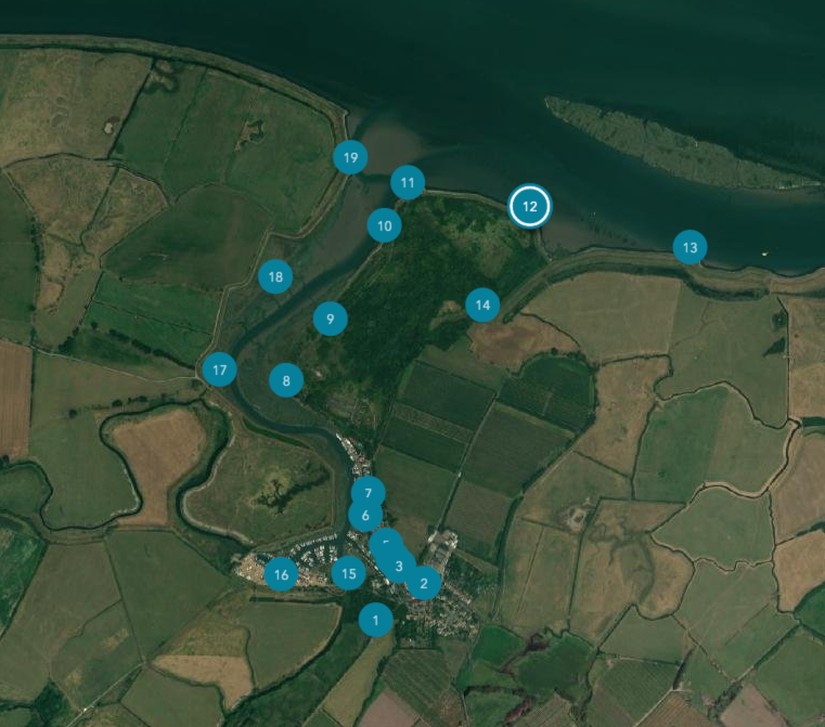
CITiZAN’s virtual Low Tide Trails are enabling people to explore coastal archaeology & heritage from home.
Preindustrial Conyer
Conyer lies in a picturesque pocket of Kent close to the Swale estuary. North coastal Kent is known to have been an active area in the Roman period & many villas & occupation sites have been found along this stretch of coast. At Conyer Roman cremation urns were discovered by gravel diggers, lying three feet below the marsh surface they contained burnt charcoal & bone.
In the Tudor period Conyer & nearby Teynham were associated with large scale fruit growing & in 1533 Richard Harris, royal fruiterer to Henry VIII, transformed the surrounding fields into the largest orchard of its day at 105 acres. Teynham even claims to be the home of the English Cherry. Allegedly Henry VIII had expressed great enjoyment in eating cherries on a trip to Flanders when Harris introduced continental strains in an attempt to please him; it’s from these cherries our native variety is derived. At this time the creek looked very different to what can be seen today. Instead of one channel connecting Conyer to the Swale there were multiple small channels with islands between, limiting the size of vessels that could access the creek. Small hoy boats would have been used for transporting fruit & local farming produced to local markets & up the Thames to London. While it’s been suggested hoy boats could have been built in Conyer there is little surviving evidence to support the idea.
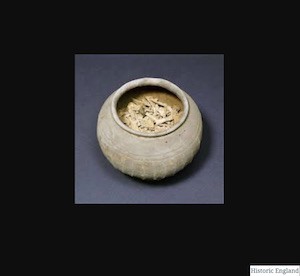
Roman cremation urns were found in Conyer beneath the marsh by gravel diggers (image: Historic England)
Early industrial Conyer
In the late 18thC Conyer still had limited accessibility for vessels, though this would improve with coastal change into the 19thC. One activity that did not require a large boat however was smuggling & in the late 18thC this formed a major source of income for a local population that would have otherwise been working for very low wages, labouring in early industries or on farms. In fact so lucrative was the activity that farmers in the area struggled to source local workers & resorted to smuggling themselves through activities like owling (the illegal exporting of English wool to France). Following the Napoleonic wars, when free trade had reached an all-time high, a coastguard station was established in Conyer as part of the Left Division of the East Kent Blockade & its associated cottages survive today.
Not far from these cottages is the site of the once well known Richardson’s cement works. Acquired in the mid 19thC this would become an impressive factory with 8 bottle kilns, a steam crane & a quay for barges, however some of the housing & infrastructure was actually repurposed from an earlier oil mill, built in 1788. The mill used steam engines to crush seeds using 5 pairs of stones & presses for the commercial manufacture of oil. The spent husks were further compressed into seed cakes & sold to be used as animal feed. Unfortunately much of the brickwork from the mill & subsequent cement factory was demolished before WW2, when hardcore was in great demand for the building of runways on airfields in the East of England.
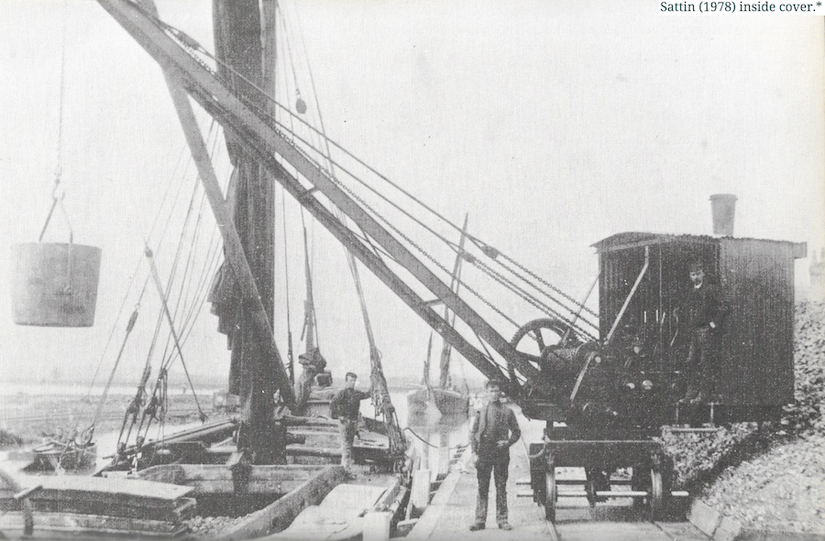
This crane & quay was owned by the Richardson’s company, who bought the earlier oil mill in the mid 19thC & converted it into a cement factory (Sattin 1978: inside cover)
Eastwoods & White's Yard
In addition to Conyer’s tidal creek, which made the transportation of goods cheap & easy, was the availability of both inexpensive labour & key raw materials associated with manufacturing brick & cement. The combination of these factors made the village attractive to the investment of Victorian industrial giants Eastwoods, who were known to situate their factories on rural coastal creeks. The company was originally founded by John Francis Eastwood in 1815, a man who had served as a military officer in the Napoleonic wars & quite possibly under the command of the Duke of Wellington. It grew as the boom in building increased demand in bricks & by the late 19thC Eastwood’s had become a powerful industrial player in the Thames Estuary region; as well as brick & cement works it had a fleet of Thames Sailing Barges & Lighter Barges serving its factories, their quays & its London wharf (which was located on the south bank at a site where the Royal Festival Hall now stands).
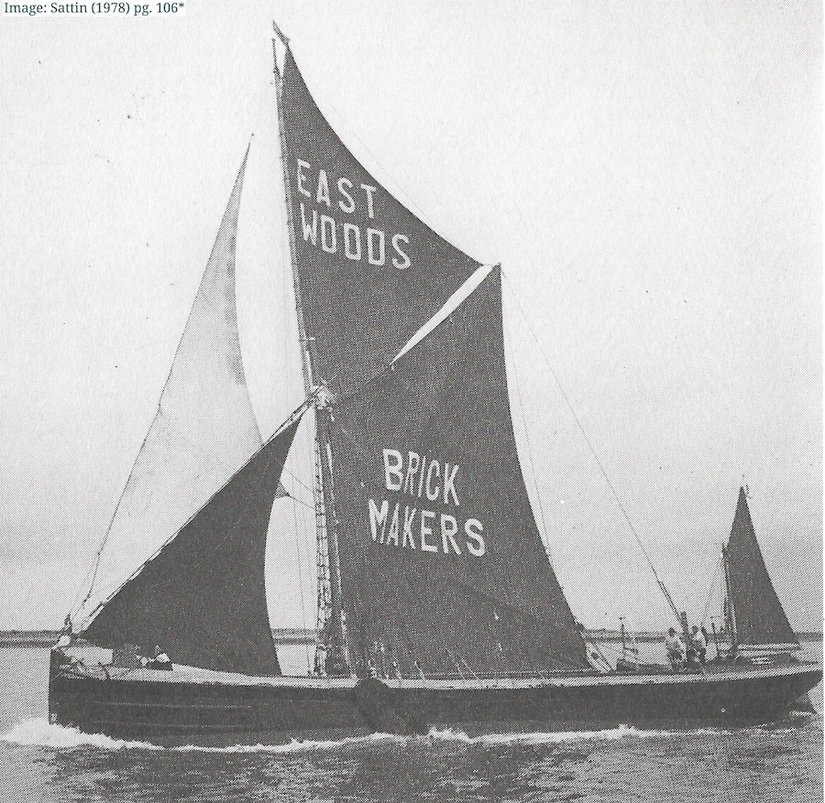
Sailing Barges were critical to the success of industries in Conyer Creek & businesses often owned their own vessels (Sattin 1978: 106)
In 1885 the Butterfly Works was built near the mouth of Conyer Creek, in an area now planned for development. Built from clinker or waster bricks (which had misfired in the kiln) Butterfly Wharf, along with its barge beds & tramlines, is still visible & publicly accessible today. Also surviving are the degenerating hulks of two Eastwoods barges Landrail & Kestrel, originally Thames Sailing Barges for exporting bricks & bringing in essential materials like Leigh sand from the Thames (used to prevent the bricks from sticking to their moulds). Both barges served the company long enough for their hulls to require a second layer of planking (known as doubling) before being converted from sailing barges to lighters. No longer rigged these would have been oared from the factory wharves to places like Fowley Island, where workers known as muddies dug mud for the brick manufacturing process in the winter months.


Landrail & Kestrel now lie abandoned in the intertidal zone, where they are subject to the forces of erosion. The first image (Sattin 1978: ) was taken in the 1970’s, the second by CITiZAN in 2019.
Barges were not only critical to the success of local industry, they also provided an important commodity for boatbuilders in Conyer, who manufactured a variety of vessels. Josiah Bird’s yard was building oyster smacks in the mid 19thC & started recording sailing barges from 1866. However it was later as White’s Yard (under the ownership of Alfred Marconi White) that it entered a golden era of barge building. Great pride was taken in barges by both builders & bargemen alike & a culture of racing & competition outside of trade created celebrated vessels & esteem amongst builders. White’s yard was notably successful & many of their boats were highly regarded for quality of build & speed. They continued producing barges for trade until WW1, when their efforts were directed to the construction of defence booms against submarines & never fully returned to barges in the same way.
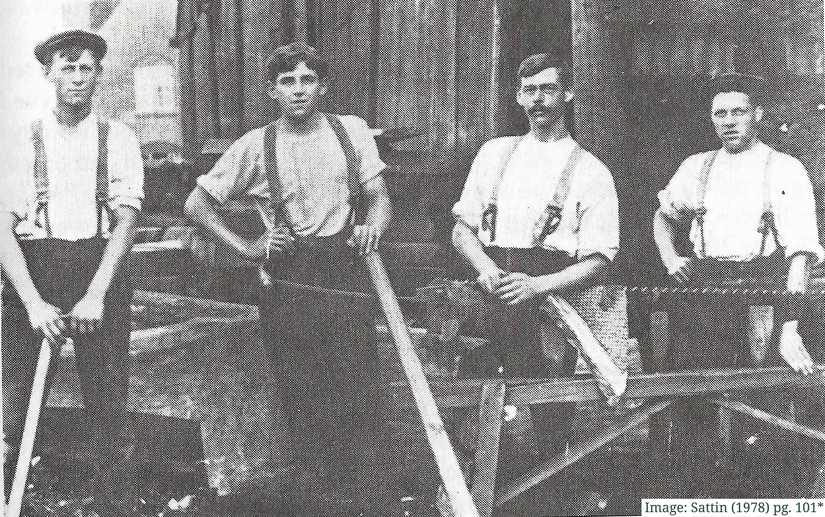
Workers at White’s yard in the early 20thC (Sattin 1978: 101)
CITiZAN’s East Kent Coast Discovery Programme had events planned to record the important intertidal hulks Landrail & Kestrel, as well as to run guided walks around the creek. Unfortunately these have now been postponed along with other public-facing activities. Instead a virtual version of the trail is available below & we’ll be updating the events page on our website to correspond with changing government guidelines as the pandemic continues.
To view the trail on this page please scroll down, or if you are using a smartphone or device we recommend following this link to view a mobile-friendly version.
Bibliography
Sattin, Don L (1978) Just off the Swale: the story of the barge building village of Conyer Rainham, Meresborough Books
Willmot, Frank G (1972) Bricks & Brickies Rainham, published privately (copyright Frank G Willmott 1972)








